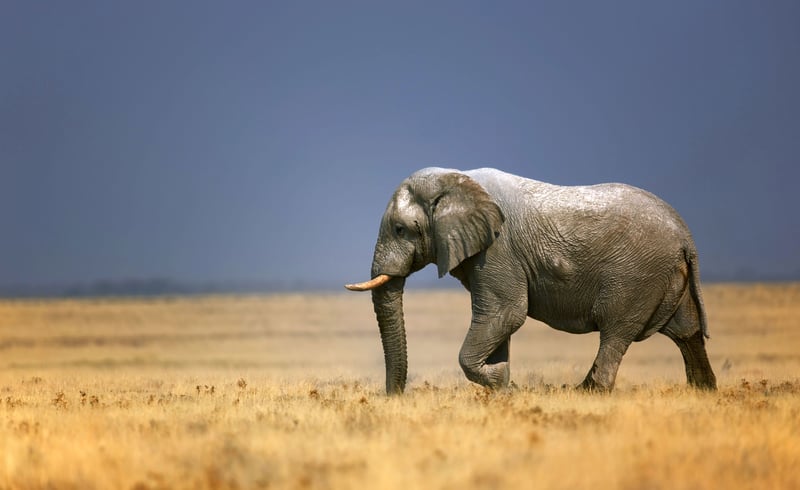
The Role of Elephants in Ecosystems
Blog
Elephants are among the most recognisable and loved animals on our planet. Their massive size, gentle eyes, and close family bonds make them symbols of the wild. But beyond their beauty and charisma lies a deeper truth: elephants are essential to the health of entire ecosystems. Without them, landscapes would change dramatically, biodiversity would decline, and many other species would suffer.
What Makes Elephants Unique?
Intelligent and Social Beings
Elephants are highly intelligent animals with remarkable memories. They live in complex social groups, often led by experienced matriarchs. These leaders remember water sources, migration paths, and safe routes—knowledge critical for survival, especially during droughts.
Their social structures and behaviors, like mourning the dead or caring for the young, show a level of emotional depth rare in the animal kingdom.
Long-Distance Travelers
Elephants cover vast distances in search of food and water. Their movements connect different habitats, spreading nutrients and seeds along the way. Their journeys maintain the health and diversity of entire landscapes.
Ecosystem Engineers: How Elephants Shape Their World
Seed Dispersers
Elephants eat a huge variety of fruits and plants. Many seeds pass through their digestive system unharmed and are deposited far from the parent plant in nutrient-rich dung. This helps forests and savannahs regenerate and ensures a wide distribution of plant species.
Without elephants, many trees and plants would struggle to spread, leading to less diverse and less resilient ecosystems.
Creating Water Holes
During dry seasons, elephants use their tusks, feet, and trunks to dig for underground water. These excavations become life-saving water holes for many other animals, from antelopes to birds.
By making water accessible, elephants support countless other species, especially during harsh droughts.
Clearing Paths and Maintaining Landscapes
As elephants move, they trample dense vegetation, creating clearings and pathways. This allows sunlight to reach the ground, enabling grasses and smaller plants to grow. Grazing animals like zebras and antelopes benefit from these new feeding grounds.
In forests, elephants break branches and even push over trees. While this might seem destructive, it actually promotes a mosaic of habitats that supports a rich variety of life.
The Ripple Effect: Elephants and Biodiversity
When elephants thrive, entire ecosystems thrive. By dispersing seeds, creating water access, and shaping vegetation, they help support:
- Insects that rely on specific plants
- Birds that nest in certain trees or feed on new growth
- Predators that depend on healthy populations of herbivores
- Humans who rely on intact ecosystems for water, soil fertility, and climate regulation
In short, elephants are keystone species. Their presence or absence has an outsized impact on the environment.
Threats Facing Elephants
Poaching for Ivory
Despite bans and international agreements, the illegal ivory trade remains a major threat. Poachers kill elephants for their tusks, devastating populations and breaking up social groups. Losing matriarchs means losing vital knowledge about survival.
Habitat Loss and Fragmentation
As human populations expand, elephant habitats shrink and become fragmented. Roads, farms, and settlements cut through traditional migration routes, forcing elephants into smaller areas with limited resources.
This leads to human-elephant conflict, where elephants raid crops and people retaliate, often violently.
Climate Change
Changing weather patterns bring longer droughts and unpredictable rainfall. Water sources dry up, and vegetation becomes scarce. Elephants, with their huge water and food needs, are especially vulnerable to these changes.
Conclusion
Elephants are more than just wildlife icons. They are architects of the wild, engineers of ecosystems, and symbols of our planet's health. Their role in seed dispersal, water access, and habitat maintenance sustains countless other species and supports biodiversity as a whole.
Yet, they face severe threats—from poaching and habitat loss to climate change. Protecting elephants is not only about saving a single species but about safeguarding the intricate web of life that depends on them.
By advocating for stronger protections and respecting their right to roam free, we can ensure that future generations inherit a world where elephants still shape the landscapes they call home.
FAQs
- Why are elephants called ecosystem engineers?
Elephants modify their environment in ways that benefit many other species. By dispersing seeds, creating water holes, and maintaining open habitats, they engineer conditions that support biodiversity.
- How does elephant poaching impact ecosystems?
Poaching reduces elephant populations, disrupting their ecological roles. Fewer elephants mean less seed dispersal, reduced habitat maintenance, and declines in biodiversity.
- What is human-elephant conflict?
As humans encroach on elephant habitats, elephants may raid crops or damage property. In retaliation, people may injure or kill elephants. Solutions include building wildlife corridors and using deterrents to reduce conflict.
- How does climate change threaten elephants?
Climate change leads to longer droughts and unpredictable weather, reducing water and food availability. Elephants, with their large needs, struggle to find enough resources in these conditions.
- What can I do to help protect elephants?
You can support conservation organizations, avoid buying ivory, spread awareness about elephant protection, and encourage policies that protect habitats and wildlife corridors.